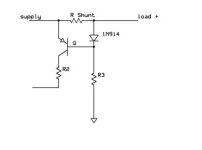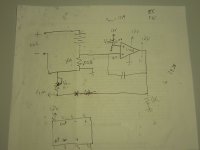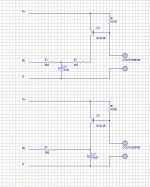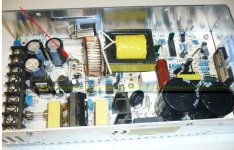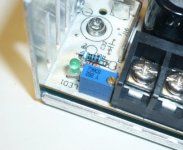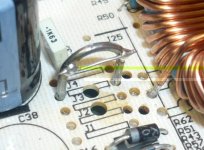Tiberius
10 kW
I am indebted to Jeremy and others for their work in this thread http://www.endless-sphere.com/forums/viewtopic.php?f=14&t=4125 where some low cost PSUs were discovered and re-engineered.
Unfortunately these do not have a constant current mode (CC) only a constant voltage (CV). In order to make them useful as battery chargers they need a current limiting circuit. (Note. Read on down the thread: Much later I discover there is a CC mode but it needs adjusting.)
One way is to run them in CV mode and put some kind of current control system in series, but that ends up dissipating a lot of heat, which sort of defeats the object of using a switched mode PSU in the first.
A better method is to find a way of turning the PSU output voltage down to just the right level that gives the desired charging current, and this turns out to be very simple. All these PSUs have a feedback loop to set the output voltage. If you inject a few mA into the right node in this loop, it will adjust the voltage to try to compensate. In the case of PSUs based around the TL494, the feedback node is pin 1 of the TL494.
Here's a simple circuit:View attachment CClimiter.JPG
As soon as the current through the sense resistor is enough to create 0.6 V the voltage starts to turn down. The only high Wattage component needed is the sense resistor - I used a load of 0.5 R's in parallel. The two 4K7s are not in theory necessary, but provide protection in case the transistor fails; I used one at each end of the wire to avoid EMC/EMI problems. It is also useful to have an indication of when the charger switches from CC to CV mode - in this case I reckoned a $5 ammeter was better than a few LEDs.
Here's the finished result:View attachment Charger755.jpg
Two sets of Andersons. Black/Red is the CV output, black/orange is the CC/CV output.
This particular one is set up for 9A/29V to charge 8s LiFePO4.
Nick
YMMV, do it at your own risk, etc, etc. There is a danger of making the PSU unstable so check it under a range of loads.
Unfortunately these do not have a constant current mode (CC) only a constant voltage (CV). In order to make them useful as battery chargers they need a current limiting circuit. (Note. Read on down the thread: Much later I discover there is a CC mode but it needs adjusting.)
One way is to run them in CV mode and put some kind of current control system in series, but that ends up dissipating a lot of heat, which sort of defeats the object of using a switched mode PSU in the first.
A better method is to find a way of turning the PSU output voltage down to just the right level that gives the desired charging current, and this turns out to be very simple. All these PSUs have a feedback loop to set the output voltage. If you inject a few mA into the right node in this loop, it will adjust the voltage to try to compensate. In the case of PSUs based around the TL494, the feedback node is pin 1 of the TL494.
Here's a simple circuit:View attachment CClimiter.JPG
As soon as the current through the sense resistor is enough to create 0.6 V the voltage starts to turn down. The only high Wattage component needed is the sense resistor - I used a load of 0.5 R's in parallel. The two 4K7s are not in theory necessary, but provide protection in case the transistor fails; I used one at each end of the wire to avoid EMC/EMI problems. It is also useful to have an indication of when the charger switches from CC to CV mode - in this case I reckoned a $5 ammeter was better than a few LEDs.
Here's the finished result:View attachment Charger755.jpg
Two sets of Andersons. Black/Red is the CV output, black/orange is the CC/CV output.
This particular one is set up for 9A/29V to charge 8s LiFePO4.
Nick
YMMV, do it at your own risk, etc, etc. There is a danger of making the PSU unstable so check it under a range of loads.


